There are few things more satisfying than star sapphires. They’re not just beautiful, they’re entertaining—especially for people like me, who sneak peeks at their jewelry when the conversation gets boring. I can’t tell you how many meetings I’ve sat in where my attention was almost entirely on a ring or bracelet.
Say you’re wearing a star sapphire ring: The six-rayed star will dance across the stone’s face as you tilt your hand this way and that. You need a single-pointed light source to see it, but when that star jumps out at you, it’s mesmerizing. (Conference room lighting is not ideal for this—one more reason I used to hate meetings.) This star effect, called asterism, is created by microscopic inclusions of a mineral called rutile in the sapphire’s crystal structure. (Okay: Sapphires are the gem form of the mineral corundum, an aluminum oxide. Rutile is basically titanium dioxide. The important thing is that they play together so nicely.)

Star sapphires are always cut as cabochons—smooth, not faceted—and they often have very high domes to maximize the star effect. They can stick out from their settings like gumdrops. Being sapphires, they come in a bunch of colors, depending on which other minerals are present. (For example: Rubies are sapphires with just the right amount of chromium.)
Most star sapphires are opaque; better ones are translucent. But if you see a clear, deep blue sapphire with a perfect star, it’s either been transformed by high heat, or it’s synthetic. There are many cooked and synthetic stones being sold as real ones.
The first manmade star sapphires, marketed as Linde Stars, were introduced by Union Carbide (!) in the 40s. My mother’s brother Melvin owned a Linde Star ring, and she and her sisters hooted behind his back because he was so fond of it. In that family, you could cut the contempt with a knife. Nevertheless, I began thinking it would be a fine thing to own a real star, and when I was quite grown up, I bought one from a trusted dealer and had it set simply in gold.
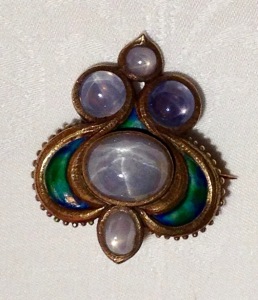
And then, many years later, I came upon the stunning brooch at left and at the top of this post. My friend Margy had found it in the depths of her late mother’s jewelry box. It didn’t resemble anything else her mother owned, or anything I’d ever seen. Margy thought maybe it was junk, but those five star sapphires told me it wasn’t. I could see they were real, which meant the setting had to be gold, and the peacock blue-green enamel (chipped, unfortunately) had to be special. On the back was a tiny hallmark: MARCUS&CO.
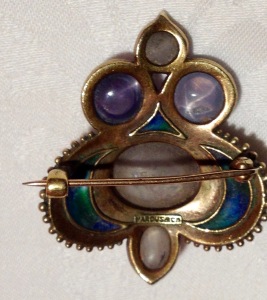
I photographed the brooch on Margy’s damask tablecloth, then took it home to do some research. Marcus & Company, it turned out, was the fanciest jeweler I’d never heard of. Herman Marcus came to the U.S. from Germany in 1850. He worked as a designer for Tiffany before starting his own firm—a firm that in its glory days produced some of the most jaw-droopingly gorgeous jewelry ever made: Art Nouveau, Renaissance Revival and Egyptian Revival pieces with beautiful colored stones and brilliant enamelwork. Some of these pieces rise to the highest levels of the jeweler’s art.
Margy didn’t love the brooch enough to want to wear it, but she was interested in selling it. I offered to see if I could find out what it was worth. I started by e-mailing a photo to a particularly posh New York retailer that had several museum-quality Marcus & Co. pieces for sale on their website. I knew Margy’s brooch was not in that league. But I was surprised when I got a curt reply saying they were not interested in talking to me about it. Apparently if I didn’t have something they could sell, I wasn’t worth their time.
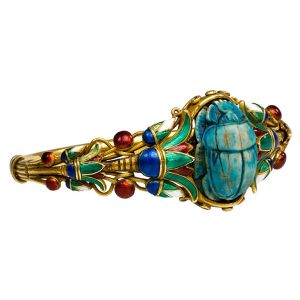
But when I called Bonham’s, one of the world’s major fine-art auction houses, they told me to come right over to their Madison Avenue location. Which is huge. One of their experts saw me immediately—a lovely young woman as fascinated with jewelry as I am. She told me the brooch was one of Marcus & Co’s Mughal-style pieces from around 1900. (India’s Mughal period, which produced magnificent jewelry, began in the 1600s.) And she said that even with the irreparable nick in the enamel, she’d estimate its value at $3,000 to $5,000. Margy sold it to her family’s longtime jeweler for rather less than that, considering it found money.

And I began wondering if there existed a Marcus & Co. piece that was simple and affordable enough for someone like me to own. I found it on Etsy, believe it or not: a graceful little Etruscan Revival ring that happened to be just my size. The owner of the shop, Monte Cristo’s, was pleased that the ring wound up on the hand of someone who really appreciates it.
Not long afterward, I saw a listing for a mint-condition version of Margy’s brooch at 1stDibs.com in its original box, “price upon request.” When dealers at 1stDibs don’t list the price of an item, they want a freaking fortune for it. And someone seems to have bought it.
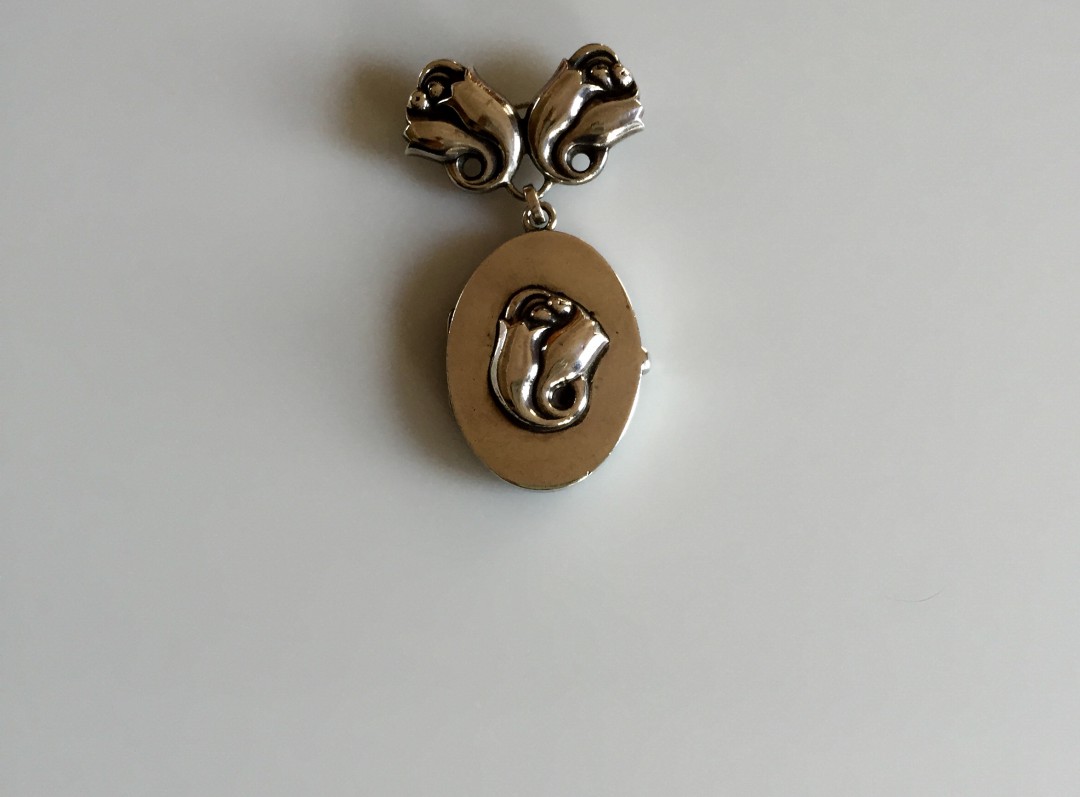
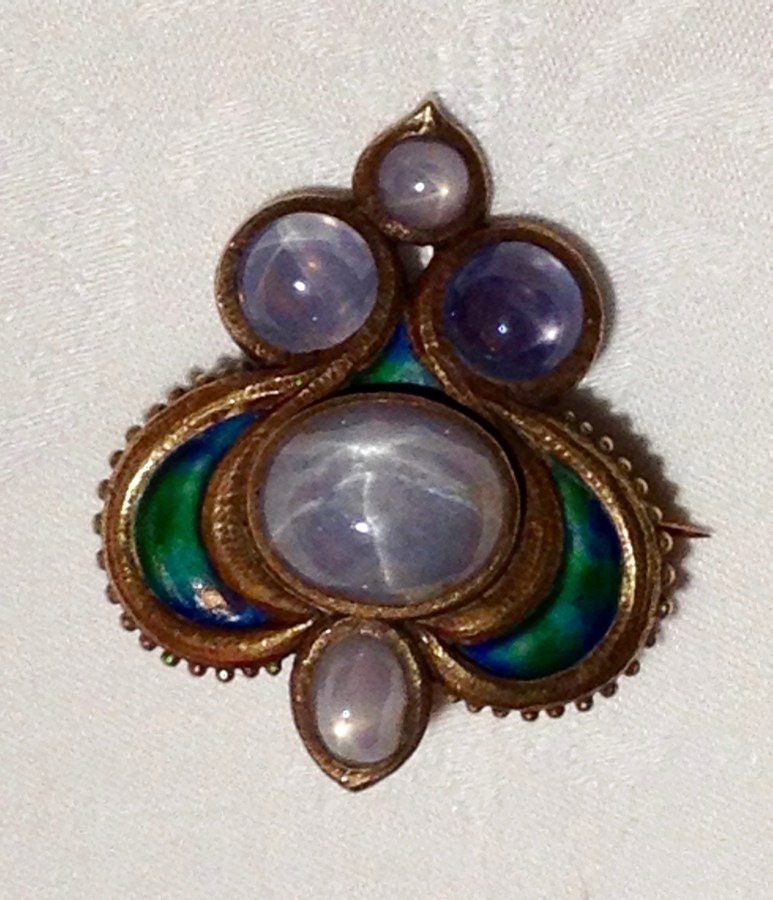
This blog is going from strength to strength. ‘In that family you could cut contempt with a knife’. Wonderful.
I EVEN love the photo caption for the little ring in the final photo: ‘Marcus & Co. Etruscan Revival (Victorian) 18K gold and natural star sapphire ring. Mine.’
LikeLike
And if you’re wondering what this week’s poem will be…so am I.
LikeLike